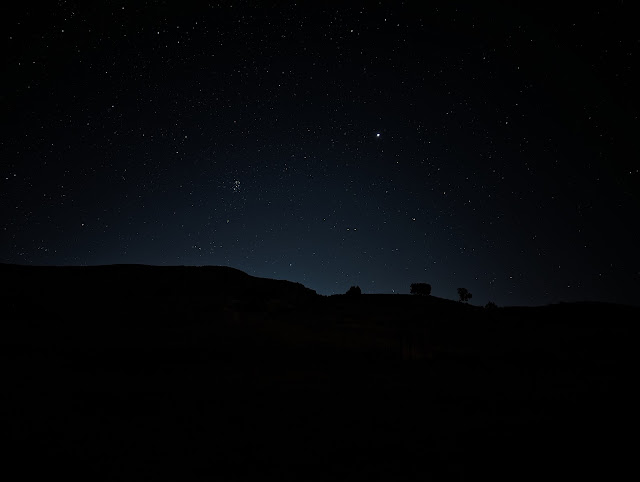Introduction and Monthly Reminders
Overall, November has been much colder. Utahns have experienced large temperature fluctuations, with snow on some days and 60° temperatures on other days. According to the extended weather forecast, this trend will continue with alternating days of low temperatures and storms, with days of higher temperatures in the 50s. As long as there are some clear nights, the fluctuations are fine by me! While I haven't been able to do any imaging or telescope viewing, I have enjoyed looking up and spotting Venus and Saturn in the early evening sky. On the nights where I have stayed out later, I've been able to see Jupiter rising with Taurus, Orion, and the Pleiades. I've also caught these wonders with Mars in the predawn sky.
Observers can still look forward to the Leonid Meteor Shower, which will peak on the 17th. The best chance to see these meteors would have been the week before or the week after the peak date due to the Full Moon. Uranus will reach opposition on the 16th, making this the best time of the year to view this planet. Mercury will reach its greatest eastern elongation on the 16th as well.
Edwin Hubble
Born 135 years ago in Missouri, Edwin Hubble excelled in many sports, including basketball, baseball, boxing, football, and track. He also enjoyed science fiction novels, an interest many would-be astronomers share. Hubble's father wanted him to pursue a career in law, where he would have no doubt excelled. However, fortunately for astronomers, Edwin preferred the sciences and studied math and astronomy, earning a PhD in astronomy from the University of Chicago in 1914. The understanding of our universe would never be the same.
During the 1920s, Hubble used the 100-inch reflecting telescope (more than eight times the size of my 12-inch telescope) at Mount Wilson Observatory in California. Hubble noticed a Cepheid variable star while observing a nebula in the Andromeda constellation. This type of star was discovered to pulsate at regular intervals, allowing astronomers to determine its distance from the Earth. It is important to note that Hubble did not discover that Cepheids could be used to determine distances. This honor belongs to Henrietta Swan Leavitt and other devoted female astronomers in the late 1800s and early 1900s. I won't go into detail about Cepheid variable stars now, but I will cover them in an upcoming post. Hubble determined the distance to the Cepheid variable star in the Andromeda Nebula and noticed that its distance was much more significant than any Cepheid in the Milky Way Galaxy. This discovery led Hubble to classify the Andromeda Nebula as a completely different galaxy and renamed it the Andromeda Galaxy. This discovery is recent enough that older astronomers still refer to the Andromeda Galaxy as the Andromeda Nebula. I had a couple of astronomy professors who mentioned that their professors still called it the Andromeda Nebula.
After realizing that the Andromeda Nebula was a galaxy, Hubble shifted the 100-inch reflecting telescope to other nebulae in the sky. By locating other Cepheid variable stars, Hubble concluded that many of these nebulae were galaxies and that our universe was much larger than previously thought. Due to this monumental discovery, Hubble began to study the light emitted from the newly classified galaxies. To his surprise, all the galaxies had light wavelengths stretched out to the red end of the visible light spectrum. This is known as a redshift.
Recall the Doppler shift or effect from an early science class that describes the change in sound as an object moves. One of the most widely used examples is an emergency vehicle siren. As it approaches a stationary observer, the sound frequency increases, creating a higher-pitched sound. The frequency decreases as the vehicle moves away, creating a lower-pitched sound. The same is true for light waves. As the light from an object approaches, it produces a higher frequency light, producing light closer to the blue end of the spectrum. If the object is moving away, it will create a lower-frequency light close to the red end of the spectrum.
During Hubble's observations, he noticed that they all redshifted no matter which direction the galaxies were from the Earth. This meant all the observed galaxies were moving away from the Earth. This does not mean that the Milky Way Galaxy is the center of the universe! When learning about this in school, an analogy of raisin bread and the expanding universe was given. I think that a balloon analogy would work better. Using a pen or marker, place several dots on the balloon representing individual galaxies. As the balloon is inflated, notice how all of the dots will move away from each other. This is a simple way to see what an expanding universe looks like! We now understand that the universe is expanding from Hubble's observations and calculations.
Due to the contributions made by Edwin Hubble, NASA named one of the most famous telescopes after him, the Hubble Space Telescope (HST). Launched in 1990, the HST has sent back millions of images of various objects from space. Astronomers were shocked by an image the HST returned when aimed at a small, dark patch of sky where nothing could be seen by the unaided eye. The image below, known as the Hubble Ultra Deep Field, shows several thousand galaxies in a region of space where nothing was thought to have existed.





No comments:
Post a Comment